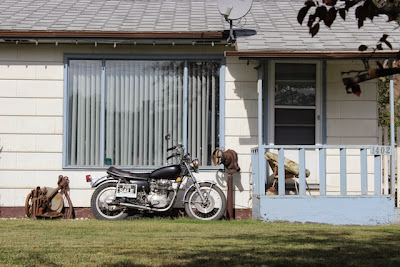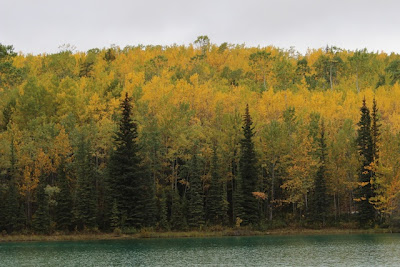"Originally perceived as a major obstacle to travel between the Coast and the Interior, the Canyon over time became the principal route for commercial and passenger traffic. Originally dangerous in the extreme, travel through the Canyon was always a formidable prospect, although today's vastly-improved modern highway does not hint at the once terrifying and difficult journey that clung to the mountain's walls as if by sheer nerve. Simon Fraser's journals speak of having to traverse sections of the canyon by a series of precipitous ladders and rock-climbs, and although several generations of road-builders had a crack at it (from 1859 onwards), the route remained a dizzying cliff-hanger until major highway improvements began in the later 1950s."
Before we got out of the canyon, we stopped at Hell's Gate tram parking lot for lunch. We made some sandwiches and checked out the tram office. $21 to ride the tram - 1000 feet down into the gorge and their tourist shops and restaurant. Not for us.
(I thought I'd written on this before and I do have a post that focuses on how the original work in the canyon resulted in disaster for the salmon and the people who lived off the salmon.)
Another couple talked to the guy at the tram and when they passed us said there was a trail to the bottom that only took half an hour.
We walked along a path, under the red bridge to the other parking lot and then came to another parking lot. The trail was wide enough for a vehicle, but gated off. And it was a beautiful forest. The sign said 1 km - a little more than half a mile.
This mourning cloak butterfly was flying and resting near me so, I thought I should get a picture.
It was was definitely down hill, but not bad. At the bottom there were no trespassing signs and danger signs, but I figured if they guy had said you could walk down, I'd do it.
From the bottom, here's one of the trams. It took about 15 minutes to get down and 20 to get back up. But you do have to cross the railroad tracks and given the long trains we saw, you could get stuck. I decided I didn't need the touristy stuff - the tram website says:
Facilities include: Simon’s Cafe, Gold Panner Gift Shop, Education Centre, Fudge Factory, Gold Panning, Simon’s Wall, Observation Decks & Suspension Bridge.I was more interested in the walk and the gorge. The water must have been low because it wasn't the rushing torrent I was expecting.
 Shortly after I got back over the tracks and started my return trip to the highway, this coal train came by. I was amazed to see the coal transported in open cars. Was there something I was missing? I didn't see any coal dust going into the air, but it was a warm, windless day.
Shortly after I got back over the tracks and started my return trip to the highway, this coal train came by. I was amazed to see the coal transported in open cars. Was there something I was missing? I didn't see any coal dust going into the air, but it was a warm, windless day.So I checked.
Coal Train Facts, a website opposed to shipping coal from Montana to Cherry Point in northwest Washington for shipment to China outlines coal dust concerns:
Because most coal trains are uncovered, they produce significant amounts of coal dust in the course of transporting the coal from one place to another. According to BNSF research, 500 pounds to a ton of of coal can escape a single loaded car. Coal dust is regarded as a nuisance, as the dust can damage the ballast and, the railway claims, cause derailments. BNSF asks that shippers pay for dust mitigation; shippers typically balk at paying. The Puget Sound coast line is notoriously rainy and windy; it is unclear as to how effective surfactants might be at containing the pulverized coal in adverse weather. There seem to be no guarantees that dust would successfully be controlled en route from the mines to the port.
Dust is also generated at the terminal site, as bulldozers continually shift and rotate the ground-up coal. Constant turnover is required to both keep the coal in one area, and also to prevent spontaneous combustion. Wind and moisture can agitate the combustive properties of coal. The potential adverse effects of coal dust on adjacent sites was a factor in the Port of Vancouver rejecting a proposal to export coal from a new export site there. The dust is notoriously difficult to control, and has proven to be a concern for residents close to Westshore, the coal port in BC. The coal at the proposed GPT terminal will be stored in open heaps on 80-105 acres located in proximity to the Cherry Point Aquatic Reserve. Cherry Point can be buffeted by high winds, winter conditions often see wind gusts in the 60-70 knot range. It seems likely that the wind will agitate the heaped, pulverized coal.
The leaching of toxic heavy metals from coal ash into water supplies is a proven problem. Exposure to arsenic, cadmium, barium, chromium, selenium, lead and mercury can cause any number of health problems, including cancers and neurological diseases. It is unknown if and to what extent these heavy metals might leach out from the coal and/or fugitive coal dust, from the train cars and at the terminal storage site, into local water supplies and into the marine environment. There are potential implications for the safety of the water we drink and the seafood we eat.The pro coal side, represented by Freedom Works in this case, tends to pick at the details, but essentially seems to acknowledge the problems - just not where the environmentalists say. Here's an example (which doesn't refer to the quote above):
- See more at: http://www.coaltrainfacts.org/key-facts#sthash.kjyRH0uH.dpuf
That passage from the white paper is instructive for a couple of other reasons. The author cites derailments and the average amount of dust lost from coal cars, but he does not say WHERE these things occur. It turns out that the two derailments in 2005 happened on the short Powder River Basin line, not far from the train's point of origin. It was attributed to coal dust fouling the ballast used as a bed for the rails. Regarding the amount of coal dust lost, what the enviros never tell you is WHERE that dust is lost. It doesn't take much effort to realize that most of the dust will be lost at the point of origin - near the mine where the cars are loaded. The further the train travels away from the loading point, the more the load will settle, meaning that less dust is going to blow away. The environmental extremist way of explaining this is to say, "It is unclear how much coal dust might escape in the Pacific Northwest ..."
Juan did a much better job of getting pictures of the spot than I did. Check his site.



















































